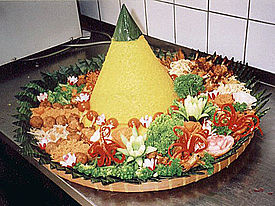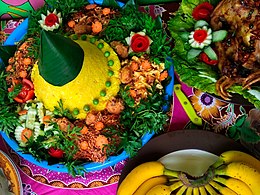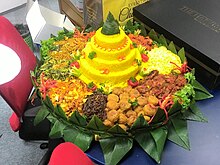food.wikisort.org - Dish
Tumpeng (Javanese: ꦠꦸꦩ꧀ꦥꦼꦁ; Balinese: ᬢᬸᬫ᭄ᬧᭂᬂ) is an Indonesian cone-shaped rice dish with side dishes of vegetables and meat originating from Javanese cuisine of Indonesia. Traditionally featured in the slamatan ceremony, the rice is made by using a cone-shaped woven bamboo container. The rice itself may be plain steamed rice, uduk rice (cooked with coconut milk), or yellow rice (uduk rice colored with kunyit (turmeric)).[1]
 Tumpeng: the cone shaped rice surrounded by assorted Indonesian dishes. | |
| Course | Main course |
|---|---|
| Place of origin | Indonesia[1] |
| Region or state | Java, Nationwide |
| Associated national cuisine | Indonesia |
| Serving temperature | Hot or room temperature |
| Main ingredients | Cone shaped rice, urab (vegetables in shredded coconut), fried chicken, fried tempeh, boiled marble egg, shredded omelette, salted anchovy and peanuts |
| Variations | Tumpeng robyong, tumpeng putih, tumpeng nasi uduk, tumpeng slametan (nasi kuning) |
 |
| This article is part of the series on |
| Indonesian cuisine Masakan Indonesia |
|---|
|
|
The rice cone is erected in the tampah (rounded woven bamboo container), covered with a banana leaf, and surrounded by assorted Indonesian dishes. In 2013, the Indonesian Ministry of Tourism and Creative Economy promoted tumpeng as one of 30 Indonesian culinary icons[2] and gave it the status of official national dish of Indonesia in 2014, describing it as "the dish that binds the diversity of Indonesian various culinary traditions."[3]
History and tradition
People in Java, Bali and Madura usually make tumpeng to celebrate important events. However, all Indonesians are familiar with tumpeng. The philosophy of tumpeng is related to the geographical condition of Indonesia, especially Java as fertile island with numerous mountains and volcanos. Tumpeng dates back to ancient Indonesian tradition that revered mountains as the abode of hyangs, the spirit of ancestors and gods. The cone-shaped rice represents the holy mountain. The feast served as a thanksgiving for the abundance of harvest or any other blessings.[citation needed]
Tumpeng is a symbol of gratitude,[1] in gratitude ceremony (syukuran or slametan), after the people pray, the top of tumpeng is cut and delivered to the most important person. He or she may be the group leader, the oldest person, or the beloved one. Then, all people in the ceremony enjoy the tumpeng together. With tumpeng, people express the gratitude to God and appreciate togetherness and harmony. An annual ceremony involving tumpeng is commonly called 'tumpengan'.[citation needed]
Tumpengs and gunungans are an essential part in the Javanese festival sekaten, huge and large amount of tumpengs are included in a big traditional parade from the palace to the grand mosque. They are prayed upon in the grand mosque, and then distributed to the people as part of the festivities celebrating the birth of the prophet Mohammed.[citation needed]
In modern times, the top of the tumpeng is given to an honoured guest in social events, ceremonies or awards. In many Indonesian cities, such as Yogyakarta, a tradition has been developed — the tumpengan ceremony the eve of 17 August — which is Indonesian independence day. The event is meant to pray for safety and welfare of the nation.[citation needed]
Surrounding dishes

The cone-shaped rice is surrounded by assorted Indonesian dishes, such as urap vegetables, ayam goreng (fried chicken), ayam bakar (grilled chicken), empal gepuk (sweet and spicy fried beef), abon sapi (beef floss), semur (beef stew in sweet soy sauce), teri kacang (anchovy with peanuts), fried prawn, telur pindang (boiled marble egg), shredded omelette, tempe orek (sweet and dry fried tempeh), perkedel kentang (mashed potato fritters), perkedel jagung (corn fritters), sambal goreng ati (liver in chilli sauce), sliced cucumbers and many other things.[4]
Traditionally there should be a balance between vegetables, egg, meat, and seafood. The composition of a traditional Javanese tumpeng is more complex because the elements must balance one another according to Javanese belief. Traditional Javanese tumpeng usually involves urap vegetables, tempeh, ayam goreng, teri kacang, fried shrimp, telur pindang, empal gepuk and sambal. After the adoption of tumpeng as the national dish, tumpeng is expected to be a dish that binds Indonesia's cooking traditions. Its side dishes might be popular Indonesian dishes, such as gado-gado, satay and rendang. Today the dishes which accompany tumpeng can be of the host's discretion.[citation needed]
Philosophical meaning
This section needs additional citations for verification. (February 2021) |
There is a philosophical meaning on every part of traditional tumpeng. According to folklore in Java and Bali, the cone-shaped tumpeng is a mystic symbol of life and ecosystems. It also symbolizes the glory of God as the Creator of nature, and the side dishes and vegetables represent the life and harmony of nature. The authentic and complete tumpeng dishes should contain at least one meat to represent a land animal, fish to represent sea creatures, an egg to represent winged beasts, and vegetables that represent a food stock provided by the plant kingdom. Usually tumpeng is served with spinach as spinach is a traditional symbol of prosperity in Javanese agricultural society.[5]
Here are the philosophical meanings behind some of the ingredients in tumpeng:
- Egg: The egg is served with the shell still on. Peeling the egg before eating it symbolizes everything a person has to plan and do before becoming a good person.
- Vegetables: A wrap of vegetables represents a good relationship with friends and neighbors. Spinach represents a safe and peaceful life; water spinach represents a person who could live through hardships; string beans represent a long life; and mungbean sprouts represent carrying ancestors' legacy.
- Catfish: Catfish represents the importance of preparing for troubles in the future. It also represents being humble, since catfish live on the bottom of ponds.
- Milkfish: The many bones of the milkfish represent good fortune and prosperity in the future.
- Anchovies: Because they live together, the anchovies represent having a good relationship with family and neighbors.
Variations
This section needs additional citations for verification. (February 2021) |

There are several variants of tumpeng, differentiated according to the ceremonies.[1]
- Tumpeng Robyong — This kind of tumpeng usually served in the traditional Javanese siraman (bridal shower) ceremony. Tumpeng is placed on bakul bamboo rice container; egg, shrimp paste, shallots and red chilli are placed on top.
- Tumpeng Nujuh Bulan — This kind of tumpeng is served in the seventh month of pregnancy (prenatal ceremony). Tumpeng is made of plain white rice. A main tumpeng is surrounded by six smaller tumpeng; all tumpengs are erected on tampah covered with banana leaf.
- Tumpeng Pungkur — Used in the ceremony for the death of a virgin or unmarried male or female. It is made from white rice surrounded only with vegetables dishes. The tumpeng later must be cut vertical into two parts evenly and placed one against another.
- Tumpeng Putih — White tumpeng, uses white rice since white symbolizes holiness in Javanese culture. This kind of tumpeng is employed in sacred ceremonies.
- Tumpeng Nasi Kuning — Yellow tumpeng: The color yellow represents gold, wealth, abundance, and high morals. This kind of tumpeng is employed in cheerful and happy festivities and celebrations, such as celebration of birth, engagement, marriage, Eid, Christmas, etc.
- Tumpeng Nasi Uduk (also called tumpeng tasyakuran) — The uduk rice (rice cooked in coconut milk) employed in the Maulud Nabi ceremony: celebrating the birthday of prophet Muhammad.
- Tumpeng Seremonial/Modifikasi — This contemporary tumpeng is relatively more open for modifications and adaptations. It depends on the discretion, taste, and request of the host.
- Mini Tumpeng ' — Mini Tumpeng is a small rice cone which is usually served for 1 person like a rice box, unique is a mini cone served in a unique place with a transparent mica lid, so food can be seen from the outside.
- Character Tumpeng Rice — Character Tumpeng Rice is usually used for birthdays, and young children love it because of its unique shape, but the unique shape can also be used like a cone for a birthday celebration.
Contemporary tradition

Today, most Indonesians serve tumpeng as a dish to celebrate a special occasion, such as a birthday party, arisan, family or neighborhood gathering, farewell party, celebrations, recitals, and many other joyous events.[6] Because of its festive and celebration value, up until now tumpeng sometimes seen as an Indonesian counterpart of birthday cake.[7] Tumpeng contests are sometimes held to commemorate Indonesian Independence day on August 17 or to commemorate women's emancipation day, the Kartini on April 21. The tumpengs in this contest are judged by decoration and taste.[citation needed]
According to Jati in Local wisdom behind Tumpeng as an icon of Indonesian traditional cuisine, in 2004, the Republic of Indonesia's Ministry of Health rolled out a tumpeng-based food pyramid to encourage healthy eating because tumpeng includes samples of food from every food group. The meat- or soy-based sides provide iron, zinc, and protein; the vegetable side dishes provide vitamins and minerals.[citation needed]
In 2009 Garuda Indonesia started offering Mini Nasi Tumpeng Nusantara as part of its new concept to highlight Indonesia's hospitality.[8]
Tumpeng is offered in Indonesian restaurants abroad, such as in neighboring Singapore[9] and the Netherlands.[10]
The building of Suharto's Purna Bhakti Pertiwi Museum in Taman Mini Indonesia Indah, Jakarta, took shape of tumpeng.[11]
See also
- Javanese cuisine
- Javanese culture
- Indonesian cuisine
- List of rice dishes
- Rice
References
- Riyan (8 April 2013). "The Rice Cone or "Nasi Tumpeng", Traditional Rice Cone, the Pride of Indonesia". Describe Indonesia. Retrieved 11 June 2014.
- "Tumpeng, Ikon Kuliner Indonesia" (in Indonesian). Travel Kompas.com. 22 April 2013. Retrieved 11 June 2014.
- Nadya Natahadibrata (10 February 2014). "Celebratory rice cone dish to represent the archipelago". The Jakarta Post. Retrieved 2014-07-09.
- "Menyiapkan Lauk Tumpeng". detikfood (in Indonesian). Retrieved 2018-01-25.
- Folklore, Javanese. "What Tumpeng Means for us Indonesian". www.indonesiapa.com. Indonesiapa Webzine. Archived from the original on 14 July 2014. Retrieved 12 July 2014.
- simple, trik. "Tumpeng, Special Dish For Special Ceremony". triksimple.com. Retrieved 20 July 2014.
- McAuliffe, Annelise. "A Look at Birthday Cakes from Around the World". Honest Cooking, Gastronomy and Travel. Retrieved 20 July 2014.
- "Garuda Indonesia Experience - Penerbangan yang Mencerminkan Indonesia" (in Indonesian). garudamagazine.com. Retrieved 11 June 2014.
- "Yellow Rice Singapore – Nasi Tumpeng". IndoChili Indonesian Restaurant.
- "Dewi Sri Restaurant". Rotterdam, The Netherlands: Tripadvisor.
- "Museum Purna Bhakti Pertiwi". touristlink. Retrieved 11 June 2014.
External links
- (in Indonesian) Resep Nasi Tumpeng
- (in English) Philosophical meaning of tumpeng
На других языках
- [en] Tumpeng
[es] Tumpeng
Tumpeng se trata de un cono de arroz basmati (teñido de amarillo debido al uso de colorante cúrcuma) que asemeja a una montaña que se sirve en una bandeja rodeado de diferentes platos de la cocina de Indonesia. Estos platos se componen de carnes y verduras propias de la región.[1] Se elabora para celebrar la ceremonia del slamatan[ru] Тумпенг
Тумпе́нг (индон. tumpeng, яв. ꦠꦸꦩ꧀ꦥꦼꦁ, tumpeng, балийск. ᬢᬸᬫ᭄ᬧᭂᬂ, tumpeng) — национальное блюдо Индонезии. Представляет собой конус, сформированный из сваренного особым образом риса, окружённую различными гарнирами. Имеет множество вариаций. Является важным атрибутом многих семейных, общинных и корпоративных застолий, а также некоторых религиозных церемоний.Другой контент может иметь иную лицензию. Перед использованием материалов сайта WikiSort.org внимательно изучите правила лицензирования конкретных элементов наполнения сайта.
WikiSort.org - проект по пересортировке и дополнению контента Википедии